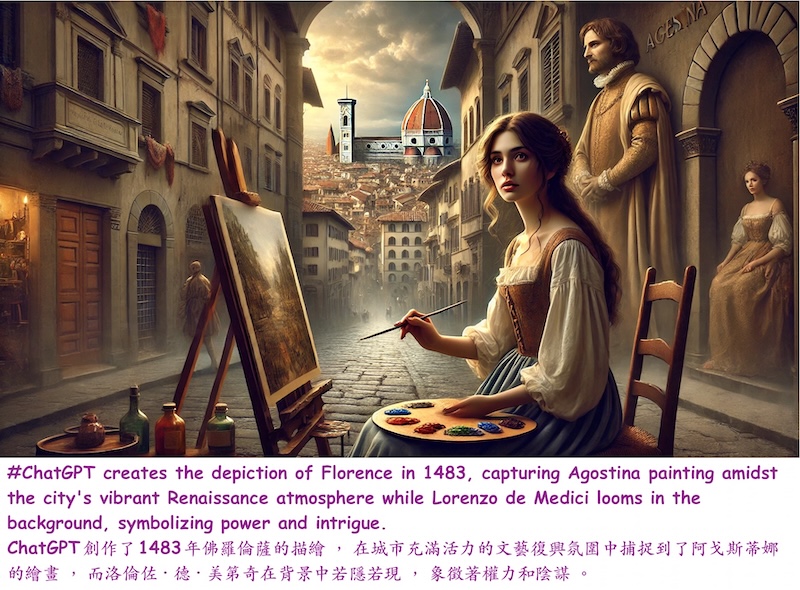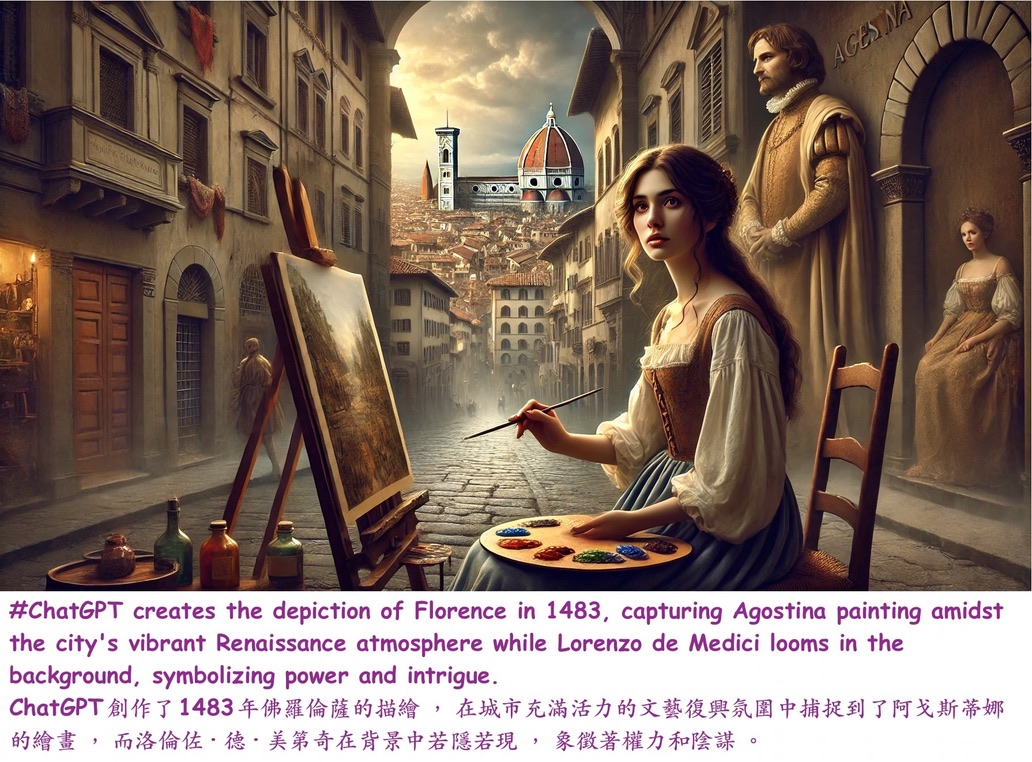Prompt: story about history

故事發生在 1483 年的佛羅倫薩,這座以藝術之美聞名的城市,正處於洛倫佐·德·梅迪奇 (Lorenzo de Medici) 鐵腕統治之下。洛倫佐是位精明而狡猾的政治家,同時也是藝術的贊助人,牢牢控制著這座城市,但反抗的低語在陰暗的巷弄中悄悄蔓延。
故事的主角是阿戈斯蒂娜 (Agostina),一位貧困和艱辛塑造了她的生命的女性。她自幼失去双亲,在繪畫的天賦中找到了慰藉,她用鮮豔的油彩捕捉著城市的靈魂。命運的一天,她的畫筆吸引了尼科洛·馬基亞維利 (Niccolò Machiavelli) 的注意,這位年輕的外交官被阿戈斯蒂娜的原始才華和叛逆精神深深迷住了。
尼科洛成為阿戈斯蒂娜的密友,他們與一個秘密的叛亂組織展開秘密會議,該組織密謀推翻洛倫佐。空氣中充滿了陰謀詭計,阿戈斯蒂娜將她的藝術作為一種隱秘的訊息,將反抗的低語隱藏在看似無辜的肖像中。她用惡意的眼神描繪洛倫佐的雙眼,用即將到來的厄運描繪梅迪奇宮殿,用對自由的渴望描繪叛軍的面容。
隨著洛倫佐加強控制,偏執狂吞噬著整個城市。每個角落都潛伏著間諜,低語變成逮捕,叛軍的計劃瀕臨崩潰。就在這時,阿戈斯蒂娜做出了一个大胆的决定。她利用进入梅迪奇宫殿的机会,揭開了她的杰作 – 一幅壁画,描绘的不是洛倫佐作为强大的统治者,而是被看不见的绳索控制的残酷傀儡。整个城市屏住了呼吸。洛倫佐愤怒而羞辱,他看到的不是一位艺术家,而是可能点燃革命的火花。
他下令逮捕阿戈斯蒂娜,引发了穿越佛羅倫薩鵝卵石街道和隐藏通道的绝望追逐。尼科洛·马基亚维利在责任和爱之间挣扎,帮助阿戈斯蒂娜逃脱,将她带到一艘开往威尼斯的秘密船上,这座以运河和低语闻名的城市。
在船上,阿戈斯蒂娜发现她被没收的画作已成为希望的象征,由逃离佛罗伦萨暴政的难民携带。阿戈斯蒂娜叛逆艺术家的故事在威尼斯的运河中回荡。艺术家们在横幅上画她的脸,诗人歌颂她的勇气,孩子们将她的名字低语为反抗的灯塔。
在威尼斯,阿戈斯蒂娜不仅找到了避难所,还找到了新的画布。她描绘了洛伦佐的垮台,她的筆觸被流亡者的泪水和对自由佛罗伦萨的渴望所激发。她的艺术成为武器,在整个意大利半岛煽动革命的低语。
潮流转向。佛罗伦萨爆发了叛乱,由阿戈斯蒂娜的愿景和梅迪奇家族日益增长的暴行所煽动。洛伦佐,曾经的城市主人,在一片石雨中逃离。自由降临佛罗伦萨,反抗的氣息弥漫在空气中。阿戈斯蒂娜不是作为一个逃犯,而是作为一个英雄归来。她的画作装饰著解放的墙壁,提醒着艺术点燃变革的力量。
The year is 1483. Florence, a city known for its artistic beauty, simmers under the iron grip of Lorenzo “the Magnificent” de Medici. Lorenzo, a shrewd politician and patron of the arts, holds the city tight, but whispers of revolt flicker in the shadowed alleyways. Enter Agostina, a woman whose life has been sculpted by poverty and hardship. Orphaned young, she finds solace in her talent for painting, capturing the city’s soul in vibrant oils. One fateful day, her brush strokes catch the eye of Niccolò Machiavelli, a young diplomat fascinated by Agostina’s raw brilliance and rebellious spirit.
Niccolò becomes Agostina’s confidante, sharing clandestine meetings with a secret rebel group plotting to overthrow Lorenzo. The air crackles with intrigue as Agostina uses her art as a coded message, hiding whispers of rebellion within seemingly innocent portraits. She paints Lorenzo’s eyes with malice, the Medici palace with impending doom, and the faces of the rebels with a yearning for freedom.
As Lorenzo tightens his grip, paranoia consumes the city. Spies lurk in every corner, whispers turn into arrests, and the rebels’ plans teeter on the brink of collapse. It is then that Agostina makes a daring decision. Using her access to the Medici palazzo, she unveils her magnum opus – a mural depicting Lorenzo not as a powerful ruler, but as a cruel puppet controlled by unseen strings. The city holds its breath. Lorenzo, enraged and humiliated, sees Agostina not as an artist, but as the spark that could ignite a revolution.
He orders her arrest, setting in motion a desperate chase through the cobbled streets and hidden passageways of Florence. Machiavelli, torn between duty and love, aids Agostina’s escape, leading her to a hidden boat bound for Venice, the fabled city of canals and whispers. Onboard, Agostina discovers her paintings, confiscated by the Medici, have become symbols of hope, carried by refugees fleeing Florence’s tyranny.
The story of Agostina, the rebellious artist, echoes across the Venetian canals. Artists paint her face on banners, poets sing of her courage, and children whisper her name as a beacon of defiance. In Venice, Agostina finds not just refuge, but a new canvas. She paints Lorenzo’s downfall, her strokes fueled by the cries of the exiled and the yearning for a free Florence. Her art becomes a weapon, inciting whispers of revolution across the Italian peninsula.
The tide turns. Florence erupts in revolt, fueled by Agostina’s vision and the Medici’s growing cruelty. Lorenzo, once the city’s master, flees under a hail of stones. Freedom dawns on Florence, the scent of rebellion heavy in the air. Agostina returns, not as a fugitive, but as a heroine. Her paintings adorn the liberated walls, reminders of the power of art to spark change.
This is just a glimpse into the captivating story of Agostina, a Florence under Medici rule, and the power of art to ignite revolutions. It’s a tale of passion, betrayal, and the unwavering spirit of freedom, all woven into the rich tapestry of European history. Do you want me to dive deeper into this story, or would you like a different one from another period?

